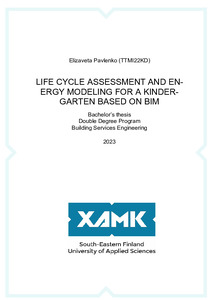Life Cycle Assessment and Energy Modeling for a Kindergarten Based on BIM
Pavlenko, Elizaveta (2023)
Pavlenko, Elizaveta
2023
All rights reserved. This publication is copyrighted. You may download, display and print it for Your own personal use. Commercial use is prohibited.
Julkaisun pysyvä osoite on
https://urn.fi/URN:NBN:fi:amk-202304064867
https://urn.fi/URN:NBN:fi:amk-202304064867
Tiivistelmä
Climate change forces us to change the usual way of life and transfer to more energy-efficient and low-carbon construction. It is an important thing that can improve our sustainable life. The global trend to carbon reduction in the building sector has indicated the need for a lifecycle assessment of buildings as a detailed analysis of environmental impacts.
The main aim of the work is to compare different energy sources for the building and analyze their impact on global warming. The goals are to reduce CO2 emissions by choosing more carbon-neutral heat-source and achieve energy efficiency in the building.
Methods of this research including background information about Finnish future regulations, and energy-efficiency solutions used in different scenarios with district heating, air heat pump, and ground source heat pump. For the case simulations the IDA ICE program was used to define the purchased energy of the building and One Click LCA to calculate the CO2 emissions for each scenario. As an example of the building, a kindergarten project based on BIM was observed.
As a result, a ground source heat pump has the lowest CO2 emissions, because of the highest COP value compared with an air heat pump. Another comparison is about materials. According to calculation and background research concrete and steel have the biggest carbon footprint therefore wood has the lowest footprint potential and the highest handprint values.
The main aim of the work is to compare different energy sources for the building and analyze their impact on global warming. The goals are to reduce CO2 emissions by choosing more carbon-neutral heat-source and achieve energy efficiency in the building.
Methods of this research including background information about Finnish future regulations, and energy-efficiency solutions used in different scenarios with district heating, air heat pump, and ground source heat pump. For the case simulations the IDA ICE program was used to define the purchased energy of the building and One Click LCA to calculate the CO2 emissions for each scenario. As an example of the building, a kindergarten project based on BIM was observed.
As a result, a ground source heat pump has the lowest CO2 emissions, because of the highest COP value compared with an air heat pump. Another comparison is about materials. According to calculation and background research concrete and steel have the biggest carbon footprint therefore wood has the lowest footprint potential and the highest handprint values.
